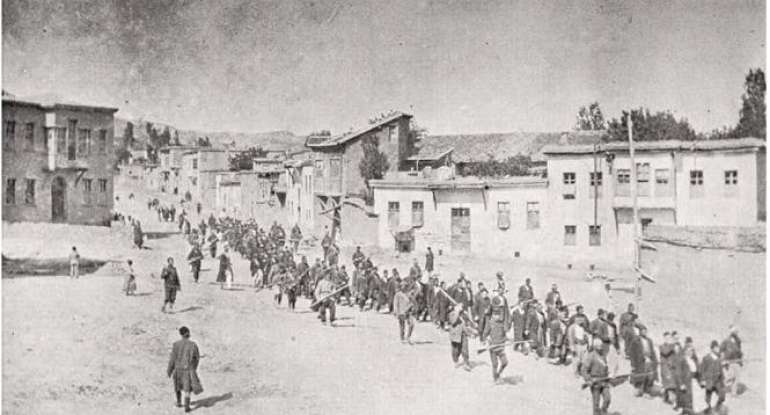
Armenian Christian civilians, escorted by armed Ottoman Muslim soldiers, are marched through Harput (known as Kharpert by Armenians, the kaza of the Mamuret-ul Aziz), to a prison in the nearby Mezireh (via Wikipedia)
Raymond Ibrahim.
Today, April 24, marks the “Great Crime,” that is, the genocide of Christians—mostly Armenians but also Assyrians—that took place under the Islamic Ottoman Empire throughout World War I. Then, the Turks liquidated approximately 1.5 million Armenians and 300,000 Assyrians.
[ … ]
… in 1920, U.S. Senate Resolution 359 heard testimony that included evidence of “[m]utilation, violation, torture, and death [which] have left their haunting memories in a hundred beautiful Armenian valleys, and the traveler in that region is seldom free from the evidence of this most colossal crime of all the ages.”
In her memoir, Ravished Armenia, Aurora Mardiganian described being raped and thrown into a harem (consistent with Islam’s rules of war). Unlike thousands of other Armenian girls who were discarded after being defiled, she managed to escape. In the city of Malatia, she saw 16 Christian girls crucified: “Each girl had been nailed alive upon her cross,” she wrote, “spikes through her feet and hands, only their hair blown by the wind, covered their bodies.” Such scenes were portrayed in the 1919 documentary film Auction of Souls, some of which is based on Mardiganian’s memoirs.
Thanks to Mr. Ibrahim for the reminder. Our own Matt Bracken also had a few words for us.
During the Armenian Genocide from 1915-23, two million Christian Turks were exterminated by being marched at gun point into burning deserts with no food or water. The Turkish gun registration laws were enacted in 1911, in the name of “public safety.” The genocide began a few years later, after the Armenians’ firearms were confiscated.
And finally, Stephen Halbrook detailed the pre-conditions for the genocide.
Hundreds of news stories have been written during the past month reporting on the 100-year anniversary of one of the darkest events in world history, a two-year killing spree that claimed the lives of an estimated 800,000 to 1.5 million Armenians.
Virtually none of these news stories, however, bothered to mention why the Armenians were defenseless against their rulers in the then Ottoman Empire: because the Ottomans had disarmed them …
While the remnant of the Ottoman Empire, today’s Turkey, disputes many of the details having to do with the Armenian genocide, most historians agree on certain basic facts. First, that the Christian Armenians had long been denied basic rights under the Ottomans’ Muslim law. Second, they were excluded from participation in the government. And third, Ottoman law made it a crime to possess a firearm without government permission. The Armenians, as British traveler H. F. B. Lynch wrote in 1901, were “rigorously prohibited from possessing firearms.”
After the Ottomans joined Germany in World War I—and a British invasion seemed imminent—the Turks decided to deport the Armenians, who they considered untrustworthy, to the interior. This deportation process became a death march, as thousands, and then tens of thousands, were murdered on their way to nowhere.
The 1915 deportation decree imposed the death penalty not only for armed resistance, but also for hiding or even helping someone else hide. The Ottomans also decreed that any firearms the Armenians possessed were to be surrendered to the government. Failing to do so, the decree said, “will be very severely punished when the arms are discovered.”
Ottoman authorities swept down on Armenian towns to search for guns. Villagers were tortured to induce confessions about hidden arms. Mass executions were ordered.
Such has been the cost of not having weapons, whether under the Bolsheviks, Idi Amin, Pol Pot, or whomever decides to act executioner.




